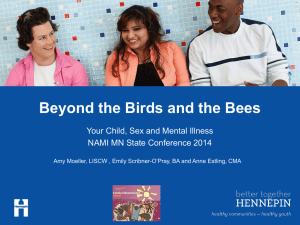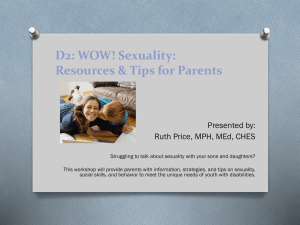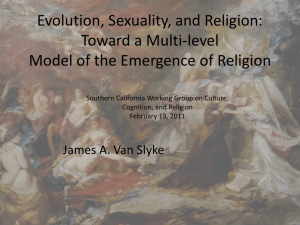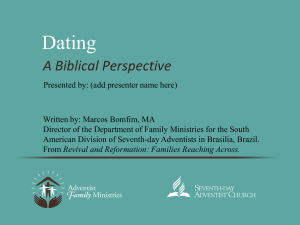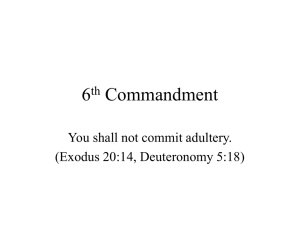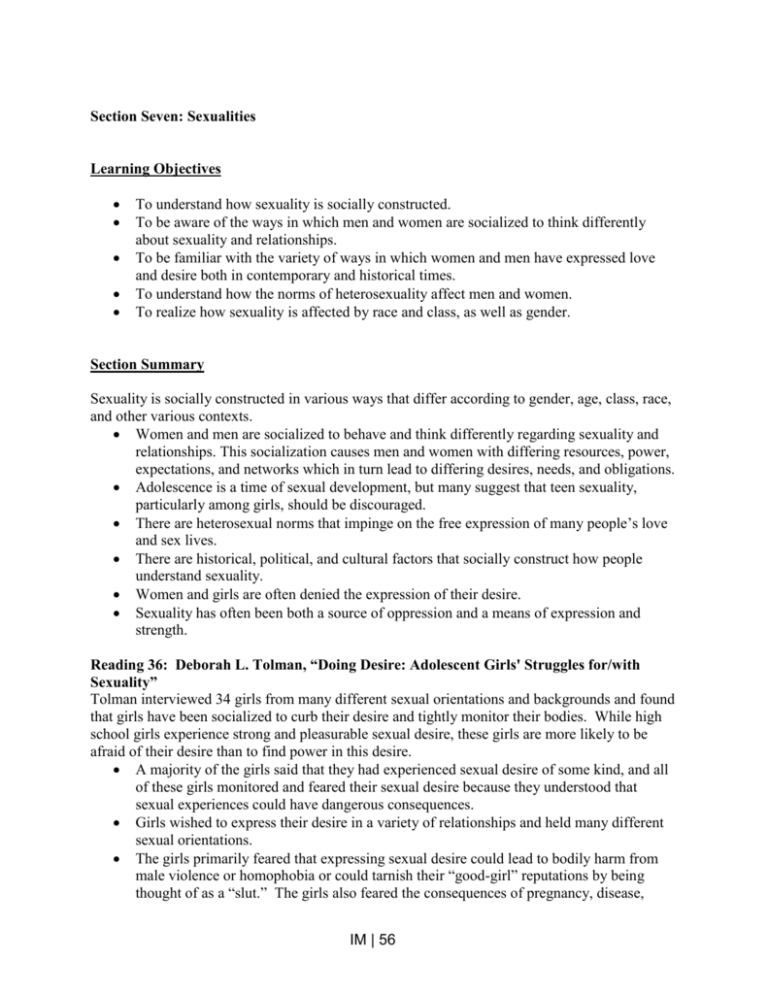
Section Seven: Sexualities
Learning Objectives
To understand how sexuality is socially constructed.
To be aware of the ways in which men and women are socialized to think differently
about sexuality and relationships.
To be familiar with the variety of ways in which women and men have expressed love
and desire both in contemporary and historical times.
To understand how the norms of heterosexuality affect men and women.
To realize how sexuality is affected by race and class, as well as gender.
Section Summary
Sexuality is socially constructed in various ways that differ according to gender, age, class, race,
and other various contexts.
Women and men are socialized to behave and think differently regarding sexuality and
relationships. This socialization causes men and women with differing resources, power,
expectations, and networks which in turn lead to differing desires, needs, and obligations.
Adolescence is a time of sexual development, but many suggest that teen sexuality,
particularly among girls, should be discouraged.
There are heterosexual norms that impinge on the free expression of many people’s love
and sex lives.
There are historical, political, and cultural factors that socially construct how people
understand sexuality.
Women and girls are often denied the expression of their desire.
Sexuality has often been both a source of oppression and a means of expression and
strength.
Reading 36: Deborah L. Tolman, “Doing Desire: Adolescent Girls' Struggles for/with
Sexuality”
Tolman interviewed 34 girls from many different sexual orientations and backgrounds and found
that girls have been socialized to curb their desire and tightly monitor their bodies. While high
school girls experience strong and pleasurable sexual desire, these girls are more likely to be
afraid of their desire than to find power in this desire.
A majority of the girls said that they had experienced sexual desire of some kind, and all
of these girls monitored and feared their sexual desire because they understood that
sexual experiences could have dangerous consequences.
Girls wished to express their desire in a variety of relationships and held many different
sexual orientations.
The girls primarily feared that expressing sexual desire could lead to bodily harm from
male violence or homophobia or could tarnish their “good-girl” reputations by being
thought of as a “slut.” The girls also feared the consequences of pregnancy, disease,
IM | 56
disappointing the adults in their lives, and breaking with hegemonic ideas of gendered
sexuality.
Many of these girls carefully monitored and stopped their bodies’ expressions of desire.
Often the girls voiced an understanding of the social factors that constrained their desire.
These factors must be changed so that women can gain power from their sexuality and
maintain a healthy understanding of their bodies.
Reading 33: Laura Hamilton, “Trading on Heterosexuality: College Women’s Gender
Strategies and Homophobia”
This article refutes the idea that women are not homophobic by using interviews and
ethnographic data on a college “party dorm” at a large Midwestern university. This research
demonstrates that heterosexual women intentionally distance themselves from lesbians in an
attempt to increase their status in the erotic marketplace. The more involved in the college party
scene, and thus more engaged in this heterosexual erotic marketplace, that women were, the
more likely they were to exclude lesbians.
The college party scene disadvantages women who are expected to compete via physical
attractiveness for access to male, particularly fraternity, controlled parties and alcohol,
and lesbians are further disadvantaged because only those actively engaged in the erotic
market (attracting male attention) were included.
The party scene encouraged women to dress and act in ways that garner male attention. In
particular women were encouraged to flirt with men for alcohol and dress scantily.
The importance women placed on men’s attention led to a hierarchy among the women
where “the blonde” was at the top. “Blondes” were white, tan, thin, and had light colored
hair and they maintained “just the right” look through a number of intentional strategies.
Heterosexual women actively worked to avoid homosexuality, and they equated gender
nonconformity with homosexuality.
The majority (30) of the women studied were active partiers who felt that partying was
central to college life. A small number of these women believed that homosexuality was
never okay, and were at times openly hostile to the lesbians on their dorm floor. The
“never okay” women cited religious beliefs, but were most likely influenced most by the
cultural logics from their homogenous hometown communities. The other active partiers
felt that homosexuality was “okay for others but not in my space.” These women
described beliefs in college values of openness and diversity, but avoided the lesbians in
their dorm and expressed misgivings about living near lesbians.
A smaller portion of this dorm floor were critical partiers(5) and nonpartiers (11).These
women were willing to have lesbian friends or to consider public lesbian identities for
themselves. The women who identified as lesbians felt shunned because of their
sexuality.
Many of the active partiers engaged in same-sex sexual behaviors such as kissing and
fondling in public. These actions were aimed at attracting male attention and were not
seen as homosexual. These performances further marginalized lesbians because it made
lesbian desire invisible and because heterosexual women felt they could invade lesbian
spaces to perform these acts.
Boxed Insert: Robin Givhan, “Hillary Clinton’s Tentative Dip Into New Neckline
Territory”
IM | 57
This box describes reaction to Senator Hillary Clinton’s wearing of a V-neck that showed a
minor amount of cleavage while speaking on the United States Senate floor (and thus captured
by C-Span). This act was surprising because women have had to conservatively dress in the
Senate and because Clinton has had a long history of being ambivalent about style and wearing
clothes that were not sexy. While other women could wear more daring and even sexy clothes as
politicians, Clinton’s lack of style and confidence in her appearance meant that this incident
caused people to feel uncomfortable.
Reading 34: Patricia Hill Collins, “Black Sexual Politics”
Racism is organized differently today, but modern racism incorporates elements of past racial
formations. The problem for the 21st century is not the “color line” of segregation, but the
seeming absence of the colorline or a pseudo-colorblind society. While Blacks are incorporated
into American culture today, they are done so in ways that replicate older racial hierarchies.
Black people remain economically disadvantaged on a global scale and the idea that Black
sexuality is “wild” continues to construct racial difference.
Black women’s public presence is expected to titillate and excite white males while black
males’ sexuality evoked fear of violence. From colonization until now, the Black female
body has been a source of entertainment and a symbol of animalistic sexuality. Although
Black males’ sexuality was similarly seen as “wild” and animalistic, it evoked fear,
particularly fears related to “defending” white females who were symbols of national
identity.
The public focus on the body of Sarah Bartman, Josephine Baker, Destiny’s Child, and
Jennifer Lopez demonstrate the history of using Black (or anyone tinged with Blackness)
women as sexual spectacles. These women were seen in a context where their
“hypersexuality” contrasted with the sexuality of white females. However, as time has
past women in these spectacles have received an increasing amount of power and money.
Although legal segregation no longer exists in the United States, racial hierarchies still
exist worldwide with people of African remaining in poverty. Patterns of desegregation
and then resegregation in the United States resemble patterns of decolonization and
recolonization worldwide.
The new racism involves new forms of global capitalism where power and wealth are
concentrated in the hands of a few corporations. Within global capitalism it is minorities,
particularly Black people, who face the devastating consequences when corporations
move, but the workers cannot.
Although Black people can vote and appear to be included in modern political structures,
they are excluded from exerting real influence because political influence is primarily
exerted by the economic and corporate elite.
The new racism relies heavily on mass media to justify racism by making it appear
natural, as though Blacks have consented to the racist messages. The mass media
packages Black sexuality in ways that whites can enjoy from a “safe distance” from
actual Blacks.
American society is sexually repressive, but at the same time, sex is everywhere in
American media.
The repressive attitude tends to censor public discussions of sex and nonmarital sexual
behaviors. In fact, conservative and heterosexist assumptions are embedded in most
research and education programs, and they negatively affect all students.
IM | 58
Although the mass media is saturated with sexual imagery, the public dialogue around
these portrayals is censored. The media’s sexual spectacles titillate more than instruct,
and they often include depictions of “deviant” Black (poor and minority) sexuality as
examples of what not to do. Collins describes how television talk shows package many
racist stereotypes of promiscuity among minorities and the poor that suggest cultural,
rather than biological, explanations for economic hierarchies.
Reading 35: Leila J. Rupp, “Loving Women in the Modern World”
The term lesbians a recent phenomenon, and doesn’t accurately cover the full range of ways that
women have engaged in same-sex sexuality or loved each other around the world throughout
history. Rupp describes how women from the 19th century to the present made sense of their
lives before and after the development of the term lesbian, describing women who married,
desired women, and/or claimed diverse identities.
Women who crossed gender lines to live as men and marry other women is one of the
most common patterns seen among women who may be said to exhibit same-sex
sexuality. Western cultures often described these women as mentally ill, though in other
cultures these women are accepted, sometimes as separate genders. In some Native
American cultures these women are called “two spirit” manly females. Woman-woman
marriage has also been found in over thirty African groups.
“Boston marriages” and “romantic friendships” that involved intense and passionate
relationships among women developed out of the sex-segregated culture of Euro-America
in the late 18th and early 19th century. These relationships often involved women of highclass status whom were expected to lack sexual desire.
Today women may marry in Belgium, Canada, Denmark, the Netherlands, Sweden and in
the U.S. state of Massachusetts (also California after the writing of this piece). Also, in
some parts of India women are allowed to marry.
The writings of women involved in romantic friendships often describe desire for women
and intense feelings. We also see this desire manifested in the court trial of Scottish
schoolteachers Jane Pirie and Marianne Woods as well as the sexually explicit diaries left
by Anne Lister who had many female lovers. The idea that prostitutes made love to each
other (not just for the pleasure of men) is found in a number of societies at this time.
Sexologists believed that women engaging in same-sex sexual behaviors and prostitutes
as suffering from hypersexuality and other mental diseases. These sexologists began to
name and define people according to the kind of people they loved and desired.
Some women, such as Anne Lister, believed that their desire for women in part defined
who they were. Others, such as the women of Lesotho, did not see their actions and
relationships with women as involving sex or as a separate identity. Some women ran
away from sexologist descriptions of their behavior as lesbian (and thus mentally ill),
while others began to embrace and be open about their lesbianism (though they did not
see it as a mental defect).
While vibrant lesbian communities were rare, ones thrived in Paris and Berlin in the early
1900’s among those who had economic independence. In many cultures such as China,
Japan, Latin America women had little option but to participate in heterosexual
marriages.
Reading 36: Michael A. Messner, “Becoming 100% Straight”
IM | 59
Messner describes how many men use sports to create and maintain their heterosexual and
masculine identities. While sports are not only played by heterosexuals, sports provide a forum
where men perform masculinity and heterosexuality.
Research is needed to question the dominance of heterosexual and masculine norms in
male sports.
Messner’s personal story and Tom Waddell’s experience as an athlete reveal the way
men use aggression and sports to cover their own homosexual desire by engaging in
hegemonic masculinity.
Dominant definitions of masculinity are narrow and focus on heterosexuality; those men
who perform these in a culturally acceptable way receive power and privilege, while
those who do not are ridiculed and stigmatized.
In institutions such as sports, power is at work in shaping people’s relationships and their
gender and sexual identities.
Discussion Questions
Reading 36: Deborah L. Tolman, “Doing Desire: Adolescent Girls' Struggles for/with
Sexuality”
1. What factors constrain the expression of desire by girls? Why do they fear sexual desire?
[Discuss the roles of social institutions, parents, peers, school, religion, etc.]
2. What was common to the experiences of all the girls? How were these girls different?
3. When do the girls cover up their feelings of desire and when do they express their
desire?
4. How can the girls’ idea that the expression of their sexuality leads to danger be changed?
What consequences might these fears have for the girls? How does Tolman suggest that
feminism could help these girls?
Reading 33: Laura Hamilton, “Trading on Heterosexuality: College Women’s Gender
Strategies and Homophobia
5. What is the erotic marketplace? Who is privileged in this arena?
6. Describe the varied relationships to the Greek party scene that the women in this study
had. How did one’s relationship to partying correspond to attitudes toward lesbians?
7. How did most of the heterosexual women believe they could identify lesbians? How did
the lesbians feel about their treatment within the party scene?
8. Is there a similar party scene on this campus? Describe what is similar or different.
9. How did heterosexual women describe their reasons for engaging in same-sex sexual
behaviors?
10. What effect does heterosexual women’s performance of lesbian eroticism have on
lesbians? Why does this act marginalize them further?
Boxed Insert: Robin Givhan, “Hillary Clinton’s Tentative Dip Into New Neckline
Territory”
IM | 60
11. Why does the author suggest that other women, but not Sen. Clinton could get away with
wearing “sexy” clothes as politicians and leaders? Do you agree or disagree? Why or why
not?
Reading 34: Patricia Hill Collins, “Black Sexual Politics”
12. In what ways has gender affected the sexual stereotypes of Blacks? How are Black men
and women seen as similar sexually? How are they seen as different?
13. What evidence does Collins provide to suggest that past racism survives in modern
images of Blacks, particularly Black women? In what other ways has racism changed and
yet had the same consequences?
14. How is the “new racism” different from old racism? What elements are new? What
remains the same?
15. How can the inclusion of Blacks into mass media replicate the hierarchies of the past?
What are some examples that Collins provides of this? Can you think of other examples
of how the media’s portrayal of Blacks feeds old stereotypes?
16. Collins suggests that the cultural focus on J-Lo’s buttocks links her to a history of gender
specific racial stereotypes of Black people. How is she similar to the other Black female
performers that Collins describes? How is she different? Does it matter that she is Latina?
Reading 35: Leila J. Rupp, “Loving Women in the Modern World”
17. Where did women marry other women, and how were they able to do so? Where is
female same-sex marriage legal today?
18. What were romantic friendships? What led to the acceptance of these relationships? Why
is it difficult to know about the sexual nature of women’s relationships with other
women?
19. Describe some examples of women who desired other women in Western cultures.
20. What was the connection between “lesbians” and prostitutes?
21. Did women embrace identities as “lesbians”? Why or why not? Where did lesbian
communities thrive?
Reading 36: Michael A. Messner, “Becoming 100% Straight”
22. Why is sport an important institution for the construction of heterosexuality? What are
some other ways that men (or women) attempt to prove their heterosexuality?
23. How did Waddell and Messner use sport to prove their masculinity? How does sport aid
in the construction of gender identities? How about sexual identities?
24. How are women who play sports treated differently than men who play sports regarding
their gender and sexual identities? What historical, structural and cultural factors
construct these differences?
Assignments and Exercises
Learning about Sex in the United States: Give students a few minutes to remember the education
they received about sex. Ask them where they learned the most about sex: from parents, school,
IM | 61
peers, books, the Internet, or some other source. Then ask students to describe what they learned
from these sources. Were they taught to fear sex and their sexual desire? What did they learn
about homosexuality or masturbation? Were their siblings or friends of a different sex taught
different things about sex? How do the experiences of female students different from those of
male students? How do students feel about the sex education they received? Use the
information they provide to describe the socially constructed nature of sexuality and how this is
gendered. Student responses could be placed in separate lists for males and for females in order
to separate out the gender differences.
Writing Assignment on Sexuality: To have students engage with an aspect of sexuality in depth,
ask them to write a paper that explores sexuality and its relationship to gender. They should
research an aspect of sexuality such as sexuality among the elderly, teenage sex, first sexual
experience, “coming out” narratives, prostitution (in the United States or in other countries),
education or political policies regarding sex, sexual abuse, or sexual harassment. Students
should use academic sources to research their papers. They should describe the socially
constructed nature of sexuality and explain how men and women have different types of
experiences with sexuality.
Sex Education: Divide students into groups and ask them to develop what they believe will be
an effective educational program on sex. They should first describe the goals of the program
(delaying sexual activity, responsible sexual activity, etc.) and then list the methods that will be
used to execute these goals. Ask students to think critically about issues of gender and
homosexuality. This exercise will allow students to explore the role of education as an
institution that shapes sexuality.
Straight and Queer Experiences with Sexuality: This exercise will allow students to explore the
relationship of the “other” and promote discussion of heterosexual privilege and norms. Ask
students to list the ways in which their lives would be different if they were of a different sexual
orientation. What might they fear? How might they experience power/privilege or
subordination? How would they be treated differently by society, parents, or friends? Would
they have had the same experiences in school? How would their sexual orientation change the
pleasure or other emotions associated with sex? Use student responses to discuss how students’
lives have been affected by norms of heterosexuality.
Sexuality in Television, Films, and Novels: This is a paper assignment designed to allow
students to explore the social construction of sexuality in the media and literature. Ask students
to describe the role of sex in a novel, movie, or television program of their choice. Ask them to
describe how the experiences of sex are different for female or male characters. Ask them to
explain the experiences of homosexual characters—or why such characters are absent. They
should identify the period and genre of their selection and describe how it breaks from or
contributes to dominant norms of sexuality. What implications does this have for people’s
understanding of sex and sexuality?
Race and Sexuality in Popular Culture: In Reading 34, Patricia Hill Collins discusses how
stereotypes of Black women and men have sexual connotations that continue to be evident in
modern popular culture. In class, show a 15 minutes clip of musical videos from BET, MTV, or
IM | 62
VH-1 that include both white and minority performers (or ask students to watch one of these for
a given time period after they have read). Ask students to think about how Reading 34 relates to
what they have watched. In class, discuss how racism and sexual spectacles have changed and
how they have stayed the same over time. In what ways does history matter for these
presentations? How are white and Black performers shown differently?
Documentary on Popular Representations of Sexuality, Race, and Gender: Show the film
Cultural Criticism and Transformation in class. In part one of this film, the important Black
feminist theorist bell hooks discusses the theoretical ideas behind “white capitalist patriarchy,”
and in part two she uses concrete examples from popular media to demonstrate cultural analysis.
Ordering information can be found at:
http://www.mediaed.org/videos/MediaRaceAndRepresentation/CulturalCriticismandTransformat
ion
Movie on Transsexuals: TransAmerica: A recent independent film uses television and stage star,
Felicity Huffman (Desperate Housewives) to explore the story of one male-to female
transsexual. This movie could be shown in class to discuss issues of issues of modern
transsexuals and also the rage and transformative nature of transsexuals. A trailer of the film can
be found at: http://www.transamerica-movie.com/ .
Film on the Representation of Gays and Lesbians: A box set containing the documentaries Off
the Straight and Narrow and Further Off the Straight and Narrow explores how gays and
lesbians have been represented at various points in popular media. These movies provide
political and cultural analysis of television's portrayal of gays, lesbians, and bisexuals.
Information on these films can be found at:
http://www.mediaed.org/cgi-bin/commerce.cgi?preadd=action&key=517-S-D
History of Sexuality Assignment: Students could be asked to research and report further on an
aspect of sexuality described in Reading 35: Leila J. Rupp, “Loving Women in the Modern
World” (such as Boston marriages, two-spirit peoples, early lesbian communities) or other
similar topics (the Stonewall Riots, the Mattachine Society, etc) . Students should present their
finding in both written form and in some type of presentation to the class (poster, film,
powerpoint, etc).
Web Links
Feminist Sexual Ethics Project
The Department of Near Eastern and Judaic Studies at Brandeis University discusses how the
three largest world religions (Christianity, Islam, and Judaism) have discussed and theorized
about sexuality. Within these pages are discussions of sexuality and slavery and links to
additional information.
http://www.brandeis.edu/projects/fse/about/about-index.html
Film: Cultural Criticism and Transformation
This film may be used to demonstrate how race, class, and sexuality are interrelated in
representations in the media. In part one of this film the important Black feminist theorist bell
IM | 63
hooks discusses the theoretical ideas behind “white capitalist patriarchy,” and in part two she
uses concrete examples from popular media to demonstrate cultural analysis.
http://www.mediaed.org/videos/MediaRaceAndRepresentation/CulturalCriticismandTransformat
ion
Film Off the Straight and Narrow and Further Off the Straight and Narrow
These films explore television's portrayal of gays, lesbians, and bisexuals. The website includes
trailers, summaries, and ordering information.
http://www.mediaed.org/cgi-bin/commerce.cgi?preadd=action&key=517-S-D
GLBTQ Encyclopedia
A variety of contributing authors, most of them professors who present research on GLBTQ
issues provide information on the history and culture of those who have not always conformed to
norms of heterosexuality. There is additional information on many of the topics discussed in
Leila J. Rupp’s “Toward a Global History of Same-Sex Sexuality.”
http://www.glbtq.com/
Planned Parenthood
Planned Parenthood has served generations of people by providing reproductive health care and
information. The organization’s website features the latest public policy news related to
sexuality. Find out how your life may be affected by laws regulating sexual behavior.
http://www.plannedparenthood.org/
Sexuality Information and Education Council
The Sexuality Information and Education Council of the United States is one of the country’s
oldest non-profit organizations dedicated to affirming that sexuality is a “healthy and natural part
of living.” Read about sexuality across the lifespan at this informative site.
http://www.siecus.org/
The Transsexual Menace
Susan Stryker describes her experiences as a male-to-female transsexual in the boxed insert. This
webpage provides additional information on the experiences of transsexuals. The Transsexual
Menace is an activist organization devoted to addressing the social and political challenges
facing trans people, spells out some of the difficulties of transitioning from one sex to the other.
http://www.themenace.net/
World Association of Sexual Health (WAS)
This international organization promotes scientifically based research, education, and clinicians
that enhance sexual health throughout the world and lifecourse. The website provides
information on the organization as well as links to additional information on sexuality.
http://www.worldsexology.org/index.asp
IM | 64




